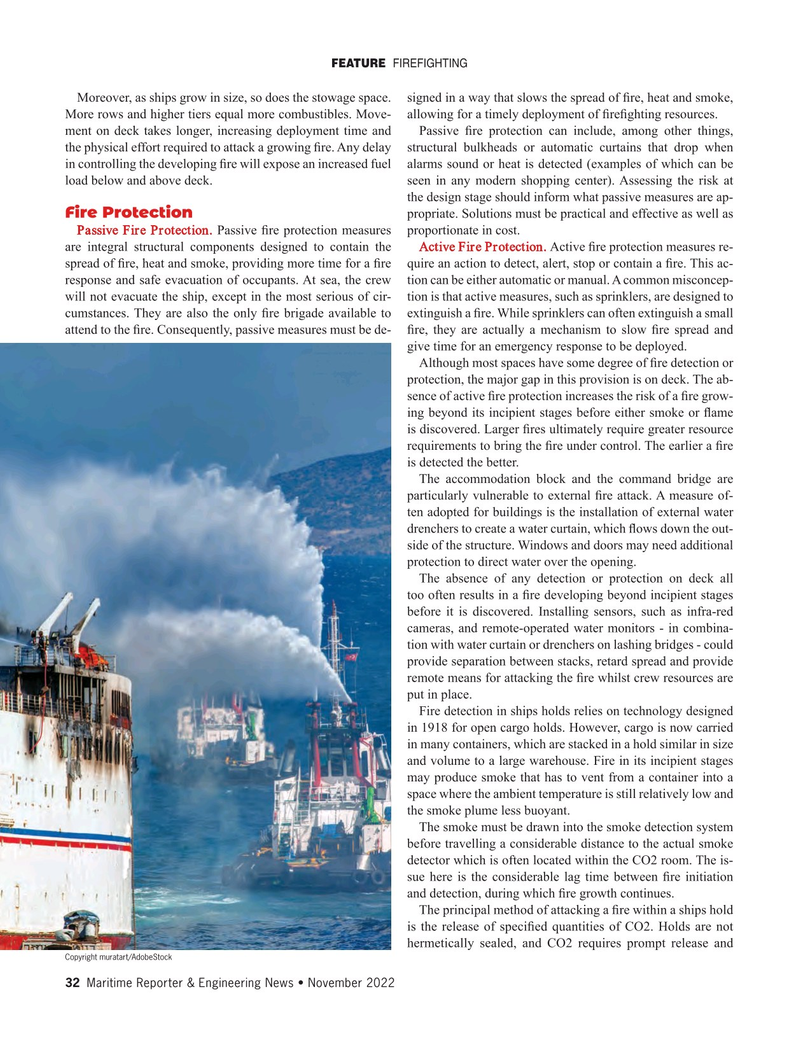
Page 32: of Maritime Reporter Magazine (November 2022)
The Workboat Edition
Read this page in Pdf, Flash or Html5 edition of November 2022 Maritime Reporter Magazine
FEATURE FIREFIGHTING
Moreover, as ships grow in size, so does the stowage space. signed in a way that slows the spread of ? re, heat and smoke,
More rows and higher tiers equal more combustibles. Move- allowing for a timely deployment of ? re? ghting resources. ment on deck takes longer, increasing deployment time and Passive ? re protection can include, among other things, the physical effort required to attack a growing ? re. Any delay structural bulkheads or automatic curtains that drop when in controlling the developing ? re will expose an increased fuel alarms sound or heat is detected (examples of which can be load below and above deck. seen in any modern shopping center). Assessing the risk at the design stage should inform what passive measures are ap-
Fire Protection propriate. Solutions must be practical and effective as well as
Passive Fire Protection. Passive ? re protection measures proportionate in cost. are integral structural components designed to contain the Active Fire Protection. Active ? re protection measures re- spread of ? re, heat and smoke, providing more time for a ? re quire an action to detect, alert, stop or contain a ? re. This ac- response and safe evacuation of occupants. At sea, the crew tion can be either automatic or manual. A common misconcep- will not evacuate the ship, except in the most serious of cir- tion is that active measures, such as sprinklers, are designed to cumstances. They are also the only ? re brigade available to extinguish a ? re. While sprinklers can often extinguish a small attend to the ? re. Consequently, passive measures must be de- ? re, they are actually a mechanism to slow ? re spread and give time for an emergency response to be deployed.
Although most spaces have some degree of ? re detection or protection, the major gap in this provision is on deck. The ab- sence of active ? re protection increases the risk of a ? re grow- ing beyond its incipient stages before either smoke or ? ame is discovered. Larger ? res ultimately require greater resource requirements to bring the ? re under control. The earlier a ? re is detected the better.
The accommodation block and the command bridge are particularly vulnerable to external ? re attack. A measure of- ten adopted for buildings is the installation of external water drenchers to create a water curtain, which ? ows down the out- side of the structure. Windows and doors may need additional protection to direct water over the opening.
The absence of any detection or protection on deck all too often results in a ? re developing beyond incipient stages before it is discovered. Installing sensors, such as infra-red cameras, and remote-operated water monitors - in combina- tion with water curtain or drenchers on lashing bridges - could provide separation between stacks, retard spread and provide remote means for attacking the ? re whilst crew resources are put in place.
Fire detection in ships holds relies on technology designed in 1918 for open cargo holds. However, cargo is now carried in many containers, which are stacked in a hold similar in size and volume to a large warehouse. Fire in its incipient stages may produce smoke that has to vent from a container into a space where the ambient temperature is still relatively low and the smoke plume less buoyant.
The smoke must be drawn into the smoke detection system before travelling a considerable distance to the actual smoke detector which is often located within the CO2 room. The is- sue here is the considerable lag time between ? re initiation and detection, during which ? re growth continues.
The principal method of attacking a ? re within a ships hold is the release of speci? ed quantities of CO2. Holds are not hermetically sealed, and CO2 requires prompt release and
Copyright muratart/AdobeStock 32 Maritime Reporter & Engineering News • November 2022
MR #11 (18-33).indd 32 11/3/2022 10:15:55 AM

 31
31

 33
33
